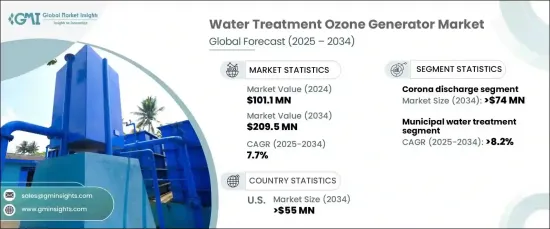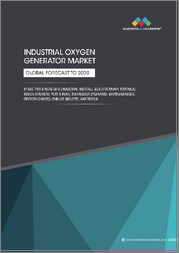
|
시장보고서
상품코드
1665207
세계의 수처리용 오존발생기 시장(2025-2034년) : 시장 기회, 성장 촉진요인, 산업 동향 분석 및 예측Water Treatment Ozone Generator Market Opportunity, Growth Drivers, Industry Trend Analysis, and Forecast 2025 - 2034 |
||||||
수처리용 오존발생기 세계 시장은 2024년에 1억 110만 달러로 평가되었고, 2025-2034년의 CAGR은 7.7%로 예측되어 대폭적인 성장을 전망하고 있습니다.
오존발생기는 물의 살균과 정화에 필수적인 매우 효과적인 산화제인 오존(O3)을 생성합니다. 오존은 물의 투명도와 안전성을 향상시키면서 박테리아, 바이러스 및 유기 오염물질을 제거하는 우수한 능력으로 알려져 있습니다. 기존의 염소 기반 방법과 달리 오존 처리는 유해한 부산물을 생성하지 않으므로 보다 안전하고 환경친화적인 정수 방법입니다.

오존발생기 수요가 증가하고 있는 배경으로는 트리할로메탄(THM) 및 할로아세트산(HAA)과 같은 염소와 관련된 유해한 소독 부산물(DBP)을 감소시키는 수처리 솔루션에 대한 요구의 증가를 들 수 있습니다. 오존 기술은 이러한 규제 과제를 극복하는 강력한 도구이며 물을 소독하기 위한 보다 깨끗하고 안전한 옵션을 제공합니다. 오존발생기는 수질을 향상시키고 환경적으로 지속 가능한 솔루션을 제공하는 능력으로 인해 다양한 산업에서의 채용이 확대되고 있습니다.
| 시장 범위 | |
|---|---|
| 시작년 | 2024년 |
| 예측연도 | 2025-2034년 |
| 시작금액 | 1억 110만 달러 |
| 예측금액 | 2억 950만 달러 |
| CAGR | 7.7% |
오존발생기는 지자체의 수처리, 폐수 재활용, 공업 폐수 처리 등 다양한 용도로 사용 가능한 범용성이 높은 기술이기 때문에 시장 또한 확대되고 있습니다. 깨끗하고 안전한 물에 대한 세계적인 수요가 다양한 부문에서 강해지고 있는 가운데 오존발생기는 수질 오염에 대처하기 위한 효과적인 솔루션으로 간주되어 시장 성장을 더욱 가속화하고 있습니다. 안전성과 효율성을 모두 향상시키는 수처리 혁신에 대한 지속적인 요구는 시장 상승 궤도를 유지할 것으로 예상됩니다.
오존발생기 시장은 기술별로 분류되며 주요 부문에는 자외선(UV), 콜드 플라즈마, 코로나 방전, 전해법이 포함됩니다. 특히 코로나 방전 기술은 시장을 독점하고 있으며 2034년까지 7,400만 달러에 달할 것으로 예상됩니다. 높은 오존 출력과 효율로 알려진 이 방법은 특히 대규모 수처리 시스템에 적합합니다. 범용성이 높기 때문에 주택부터 지자체, 공업용까지 폭넓은 설비에 최적이며, 세계적인 채용이 한층 더 가속화될 것으로 예상됩니다.
용도별로 수처리용 오존발생기 시장은 산업 공정 수처리, 지자체 수처리 및 기타 부문으로 구분됩니다. 지자체의 수처리 부문은 2034년까지 연평균 복합 성장률(CAGR) 8.2%라는 경이로운 성장을 전망하고 있습니다. 지자체가 첨단 살균 방법을 채택할 필요성을 요구함에 따라 오존발생기가 강력한 솔루션으로 사용되고 있습니다. 이러한 시스템은 유해한 미생물과 오염물질 제거에 탁월한 성능을 발휘하여 기존의 염소 소독보다 효율적이고 안전한 결과를 제공합니다.
미국에서는 수처리용 오존발생기 시장이 2034년까지 5,500만 달러에 달할 것으로 예측됩니다. 이 성장의 주요 요인은 병원체와 오염물질의 효과적인 제거를 의무화하는 안전식수법이나 수질정화법 등의 엄격한 수질 규제입니다. 게다가 지방정부의 수처리 인프라를 업그레이드하기 위한 지속적인 투자는 오존발생기 채택을 추진합니다. 이러한 기술은 효율성, 안전성 및 규제 준수에 대한 현대적인 요구를 충족시키는 데 필수적이며 미국의 수처리 솔루션의 미래에 중요한 요소가 되었습니다.
목차
제1장 조사 방법 및 조사 범위
- 시장 정의
- 기본 추정 및 계산
- 예측 계산
- 1차 조사 및 검증
- 1차 정보
- 데이터 마이닝 소스
- 시장 정의
제2장 주요 요약
제3장 산업 인사이트
- 산업 생태계
- 규제 상황
- 산업에 영향을 미치는 요인
- 성장 촉진요인
- 산업의 잠재적 리스크 및 과제
- 성장 가능성 분석
- Porter's Five Forces 분석
- 공급기업의 협상력
- 구매자의 협상력
- 신규 참가업체의 위협
- 대체품의 위협
- PESTEL 분석
제4장 경쟁 구도
- 소개
- 전략 대시보드
- 혁신 및 기술 전망
제5장 시장 규모 및 예측 : 기술별(2021-2034년)
- 주요 동향
- 자외선
- 콜드 플라즈마
- 코로나 방전
- 전해
제6장 시장 규모 및 예측 : 용도별(2021-2034년)
- 주요 동향
- 지자체 수처리
- 산업 공정 수처리
- 기타
제7장 시장 규모 및 예측 : 최종 용도별(2021-2034년)
- 주요 동향
- 상업용
- 지자체
- 산업용
제8장 시장 규모 및 예측 : 지역별(2021-2034년)
- 주요 동향
- 북미
- 미국
- 캐나다
- 유럽
- 독일
- 영국
- 프랑스
- 러시아
- 이탈리아
- 스페인
- 아시아태평양
- 중국
- 호주
- 인도
- 일본
- 한국
- 중동 및 아프리카
- 사우디아라비아
- 아랍에미리트(UAE)
- 이집트
- 터키
- 남아프리카
- 라틴아메리카
- 브라질
- 아르헨티나
제9장 기업 프로파일
- Chemtronics
- EBARA Technologies
- Faraday Ozone
- Lenntech Water Treatment
- Mitsubishi Electric
- Ozone Solutions
- Ozonetek
- Primozone
- SUEZ
- Toshiba
The Global Water Treatment Ozone Generator Market, valued at USD 101.1 million in 2024, is set to experience substantial growth with a projected compound annual growth rate (CAGR) of 7.7% from 2025 to 2034. These ozone generators produce ozone (O3), a highly effective oxidizing agent crucial for water disinfection and purification. Ozone is known for its superior ability to eliminate bacteria, viruses, and organic contaminants, all while improving water clarity and safety. Unlike traditional chlorine-based methods, ozone treatment produces no harmful byproducts, making it a safer, environmentally friendly alternative for water purification.

A key driver behind the growing demand for ozone generators is the increasing need for water treatment solutions that reduce harmful disinfection byproducts (DBPs), such as trihalomethanes (THMs) and haloacetic acids (HAAs), which are commonly associated with chlorine. Ozone technology is a powerful tool in overcoming these regulatory challenges, offering a cleaner, safer option for disinfecting water. The ability of ozone generators to enhance water quality and provide an environmentally sustainable solution is fueling their adoption across various industries.
| Market Scope | |
|---|---|
| Start Year | 2024 |
| Forecast Year | 2025-2034 |
| Start Value | $101.1 Million |
| Forecast Value | $209.5 Million |
| CAGR | 7.7% |
The market for ozone generators is also expanding due to the technology's versatility in several applications, including municipal water treatment, wastewater recycling, and industrial effluent treatment. As the global demand for clean, safe water intensifies across multiple sectors, ozone generators are increasingly being seen as a viable solution for tackling water contamination, further accelerating market growth. The continuous need for water treatment innovations that improve both safety and efficiency is expected to sustain the upward market trajectory.
The ozone generator market is divided by technology, with key segments including ultraviolet (UV), cold plasma, corona discharge, and electrolytic methods. The corona discharge technology, in particular, is anticipated to dominate the market, reaching USD 74 million by 2034. Known for its high ozone output and efficiency, this method is particularly suitable for large-scale water treatment systems. Its versatility makes it ideal for a wide range of installations, from residential to municipal and industrial applications, which will further drive its adoption globally.
In terms of application, the water treatment ozone generator market is segmented into industrial process water treatment, municipal water treatment, and other sectors. The municipal water treatment segment is expected to grow at an impressive CAGR of 8.2% through 2034. As municipalities face increasing pressure to adopt advanced disinfection methods, ozone generators are becoming a go-to solution. These systems offer superior performance in eliminating harmful microorganisms and contaminants, delivering more efficient and safer results than traditional chlorine disinfection.
In the U.S., the water treatment ozone generator market is projected to reach USD 55 million by 2034. This growth is largely driven by stringent water quality regulations such as the Safe Drinking Water Act and Clean Water Act, which mandate effective pathogen and pollutant removal. Additionally, continued investments in upgrading municipal water treatment infrastructure will further propel the adoption of ozone generators. These technologies are essential in meeting modern demands for efficiency, safety, and regulatory compliance, positioning them as a key component in the future of U.S. water treatment solutions.
Table of Contents
Chapter 1 Methodology & Scope
- 1.1 Market definitions
- 1.2 Base estimates & calculations
- 1.3 Forecast calculation
- 1.4 Primary research & validation
- 1.4.1 Primary sources
- 1.4.2 Data mining sources
- 1.5 Market definitions
Chapter 2 Executive Summary
- 2.1 Industry synopsis, 2021 – 2034
Chapter 3 Industry Insights
- 3.1 Industry ecosystem
- 3.2 Regulatory landscape
- 3.3 Industry impact forces
- 3.3.1 Growth drivers
- 3.3.2 Industry pitfalls & challenges
- 3.4 Growth potential analysis
- 3.5 Porter's analysis
- 3.5.1 Bargaining power of suppliers
- 3.5.2 Bargaining power of buyers
- 3.5.3 Threat of new entrants
- 3.5.4 Threat of substitutes
- 3.6 PESTEL analysis
Chapter 4 Competitive landscape, 2024
- 4.1 Introduction
- 4.2 Strategic dashboard
- 4.3 Innovation & technology landscape
Chapter 5 Market Size and Forecast, By Technology, 2021 – 2034 (USD Million & Units)
- 5.1 Key trends
- 5.2 Ultraviolet
- 5.3 Cold plasma
- 5.4 Corona discharge
- 5.5 Electrolytic
Chapter 6 Market Size and Forecast, By Application, 2021 – 2034 (USD Million & Units)
- 6.1 Key trends
- 6.2 Municipal water treatment
- 6.3 Industrial process water treatment
- 6.4 Others
Chapter 7 Market Size and Forecast, By End Use, 2021 – 2034 (USD Million & Units)
- 7.1 Key trends
- 7.2 Commercial
- 7.3 Municipal
- 7.4 Industrial
Chapter 8 Market Size and Forecast, By Region, 2021 – 2034 (USD Million & Units)
- 8.1 Key trends
- 8.2 North America
- 8.2.1 U.S.
- 8.2.2 Canada
- 8.3 Europe
- 8.3.1 Germany
- 8.3.2 UK
- 8.3.3 France
- 8.3.4 Russia
- 8.3.5 Italy
- 8.3.6 Spain
- 8.4 Asia Pacific
- 8.4.1 China
- 8.4.2 Australia
- 8.4.3 India
- 8.4.4 Japan
- 8.4.5 South Korea
- 8.5 Middle East & Africa
- 8.5.1 Saudi Arabia
- 8.5.2 UAE
- 8.5.3 Egypt
- 8.5.4 Turkey
- 8.5.5 South Africa
- 8.6 Latin America
- 8.6.1 Brazil
- 8.6.2 Argentina
Chapter 9 Company Profiles
- 9.1 Chemtronics
- 9.2 EBARA Technologies
- 9.3 Faraday Ozone
- 9.4 Lenntech Water Treatment
- 9.5 Mitsubishi Electric
- 9.6 Ozone Solutions
- 9.7 Ozonetek
- 9.8 Primozone
- 9.9 SUEZ
- 9.10 Toshiba



















